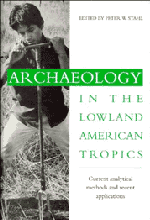Book contents
- Frontmatter
- Contents
- List of figures
- List of tables
- List of contributors
- Introduction
- 1 Archaeological survey and site discovery in the forested neotropics
- 2 The archaeology of community organization in the tropical lowlands: a case study from Puerto Rico
- 3 Archaeological methods for the study of ancient landscapes of the Llanos de Mojos in the Bolivian Amazon
- 4 Searching for environmental stress: climatic and anthropogenic influences on the landscape of Colombia
- 5 “Doing” paleoethnobotany in the tropical lowlands: adaptation and innovation in methodology
- 6 Plant microfossils and their application in the New World tropics
- 7 Differential preservation histories affecting the mammalian zooarchaeological record from the forested neotropical lowlands
- 8 Biological research with archaeologically recovered human remains from Ecuador: methodological issues
- 9 Interpreting dietary maize from bone stable isotopes in the American tropics: the state of the art
- 10 From potsherds to pots: a first step in constructing cultural context from tropical forest archaeology
- 11 Returning to Pueblo Viejo: history and archaeology of the Chachi (Ecuador)
- References
- Index
Introduction
Published online by Cambridge University Press: 23 November 2009
- Frontmatter
- Contents
- List of figures
- List of tables
- List of contributors
- Introduction
- 1 Archaeological survey and site discovery in the forested neotropics
- 2 The archaeology of community organization in the tropical lowlands: a case study from Puerto Rico
- 3 Archaeological methods for the study of ancient landscapes of the Llanos de Mojos in the Bolivian Amazon
- 4 Searching for environmental stress: climatic and anthropogenic influences on the landscape of Colombia
- 5 “Doing” paleoethnobotany in the tropical lowlands: adaptation and innovation in methodology
- 6 Plant microfossils and their application in the New World tropics
- 7 Differential preservation histories affecting the mammalian zooarchaeological record from the forested neotropical lowlands
- 8 Biological research with archaeologically recovered human remains from Ecuador: methodological issues
- 9 Interpreting dietary maize from bone stable isotopes in the American tropics: the state of the art
- 10 From potsherds to pots: a first step in constructing cultural context from tropical forest archaeology
- 11 Returning to Pueblo Viejo: history and archaeology of the Chachi (Ecuador)
- References
- Index
Summary
The long neglected lowland American tropics have only recently received any significant amount of scientific attention. This unprecedented explosion of interest is the unfortunate product of a conspiracy of events whose global repercussions have forced us to confront the dramatic consequences of rapid ecosystemic degradation, declining biodiversity, and cultural extinction. As we race against time to learn as much as possible about these quickly transforming environments, we are consistently frustrated and humbled by how little we actually know. In our search for a clearer appreciation of the future implications that current policies and practices may hold, we are simultaneously compelled to reflect on the area's rich and complex archaeological past.
The relative paucity of systematic archaeological investigation conducted throughout this vast region is generally attributed to some combination of logistical constraints, lack of ground visibility, meager preservation, and/or an historic deprecation of lowland environments. Much of our knowledge of lowland neotropical prehistory is built upon a scattered patchwork of museum pieces and fortuitous observations. Together with a healthy dose of speculation, these isolated bits of data are linked together via trait comparison, and correlated with reliable observations obtained from the few geographically disparate scientific excavations undertaken so far.
Amongst the small group of intrepid archaeological pioneers whose efforts unearthed an early glimpse at the prehistoric world of the vast South American lowlands, Donald W. Lathrap occupies a prominent niche.
- Type
- Chapter
- Information
- Archaeology in the Lowland American TropicsCurrent Analytical Methods and Applications, pp. 1 - 6Publisher: Cambridge University PressPrint publication year: 1995
- 1
- Cited by

